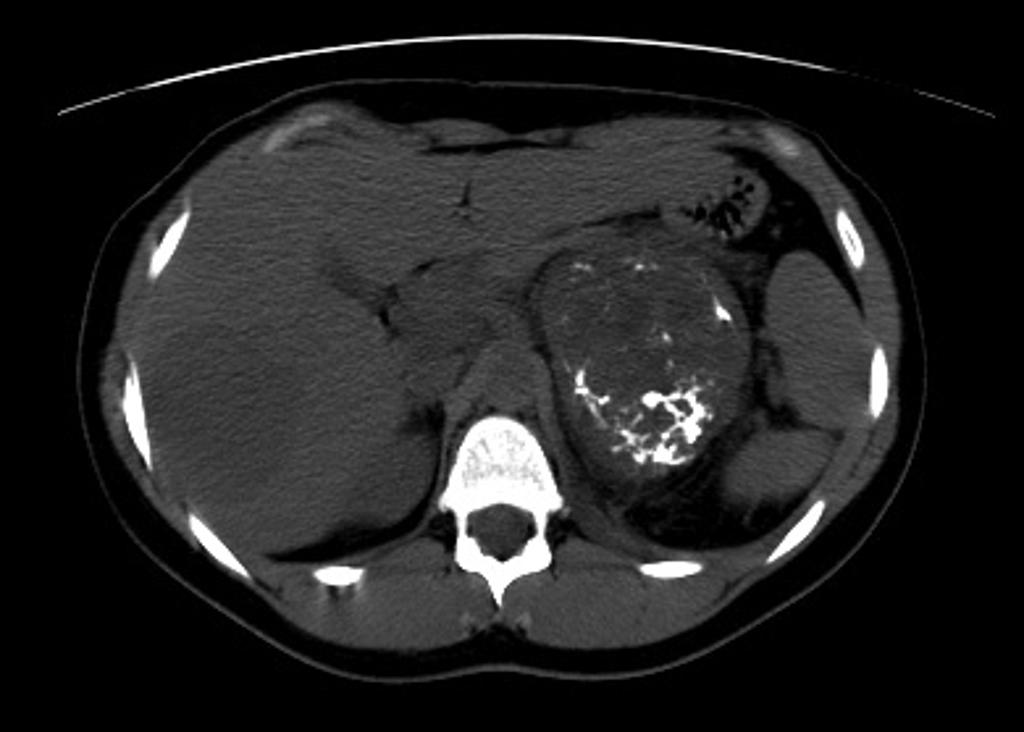Adrenocortical carcinoma CT
|
Adrenocortical carcinoma Microchapters |
|
Differentiating Adrenocortical carcinoma from other Diseases |
|---|
|
Diagnosis |
|
Treatment |
|
Case Study |
|
Adrenocortical carcinoma CT On the Web |
|
American Roentgen Ray Society Images of Adrenocortical carcinoma CT |
|
Risk calculators and risk factors for Adrenocortical carcinoma CT |
Editor-In-Chief: C. Michael Gibson, M.S., M.D. [1]; Associate Editor(s)-in-Chief: Ahmad Al Maradni, M.D. [2] Mohammed Abdelwahed M.D[3]
Overview
Adrenal CT scan may be helpful in the diagnosis of Adrenocortical carcinoma (ACC) and in differentiating it from other diseases, such as adrenocortical adenoma. Signs such as internal hemorrhage, calcifications, CT density >10 HU or necrosis increase the chances of ACC. Contrast-enhanced CT scan is a reliable method of disease staging, identifying common metastatic sites such as regional and para-aortic lymph nodes, lungs, liver, and bones.[1] CT imaging of the chest, liver, and bone scan are used for staging workup to detect metastasis.
Key CT Findings in adrenocortical carcinoma
CT scan of the abdomen is useful for:
- Identifying the site of the tumor,
- Differentiating it from other diseases, such as adrenocortical adenoma,
- Determining the extent of invasion of the tumor into surrounding organs and tissues.
Following signs can be detected on CT scan: [2]
- ACCs are large, heterogeneous enhancing masses of soft tissue attenuation.
- Internal hemorrhage is seen as ill-defined areas of increased attenuation on non-contrast-enhanced CT and as areas of high signal intensity on T1-weighted images.
- Areas of necrosis have low attenuation on non–contrast-enhanced CT, high signal intensity on T2-weighted images and do not enhance after administration of intravenous contrast. [3]
- Calcifications can be present in 30% of cases. These may be micro-calcifications and usually centrally located. Calcification is also present in other adrenal pathologies such as myelolipoma and 10% of pheochromocytomas; therefore, it is not a specific sign.[4] CT imaging is the best imaging for calcification.
- Some ACCs may contain intracellular lipid and macroscopic fat resulting in CT density measurements of 10 HU in portions of the tumor.[5]
- Contrast-enhanced imaging often demonstrates heterogeneous, irregular peripheral enhancement with central non-enhancing areas secondary to hemorrhage or necrosis.
- Contrast-enhanced CT scan is a reliable method of disease staging, identifying common metastatic sites such as regional and para-aortic lymph nodes, lungs, liver, and bones.[1]
- CT imaging of the chest, liver, and bone scan are used for staging workup to detect the metastasis.
| Properities | Adrenocortical carcinoma | Adrenocortical adenoma |
|---|---|---|
| Size | >4 cm | <4 cm |
| Necrosis | + | - |
| Hemorrhage | + | - |
| Calcification | + | - |
| CT density | Heterogeneous, >10 HU | Homogeneous, <10 HU |
| Chemical-shift MRI | Heterogeneous signal drop +/- | Homogeneous signal drop |
| Chemical-shift contrast enhancement | Heterogeneous, absolute % washout <60% | Homogeneous, absolute % washout >60% |
| SUV on [18F]FDG PET/CT | Adrenal to liver SUV ratio >1.45 | Adrenal to liver SUV ratio <1.45 |


References
- ↑ 1.0 1.1 Bharwani N, Rockall AG, Sahdev A, Gueorguiev M, Drake W, Grossman AB; et al. (2011). "Adrenocortical carcinoma: the range of appearances on CT and MRI". AJR Am J Roentgenol. 196 (6): W706–14. doi:10.2214/AJR.10.5540. PMID 21606258.
- ↑ Bharwani N, Rockall AG, Sahdev A, Gueorguiev M, Drake W, Grossman AB; et al. (2011). "Adrenocortical carcinoma: the range of appearances on CT and MRI". AJR Am J Roentgenol. 196 (6): W706–14. doi:10.2214/AJR.10.5540. PMID 21606258.
- ↑ Krebs TL, Wagner BJ (1998). "MR imaging of the adrenal gland: radiologic-pathologic correlation". Radiographics. 18 (6): 1425–40. doi:10.1148/radiographics.18.6.9821192. PMID 9821192.
- ↑ Fishman EK, Deutch BM, Hartman DS, Goldman SM, Zerhouni EA, Siegelman SS (1987). "Primary adrenocortical carcinoma: CT evaluation with clinical correlation". AJR Am J Roentgenol. 148 (3): 531–5. doi:10.2214/ajr.148.3.531. PMID 3492881.
- ↑ Egbert N, Elsayes KM, Azar S, Caoili EM (2010). "Computed tomography of adrenocortical carcinoma containing macroscopic fat". Cancer Imaging. 10: 198–200. doi:10.1102/1470-7330.2010.0029. PMC 2999409. PMID 21067996.